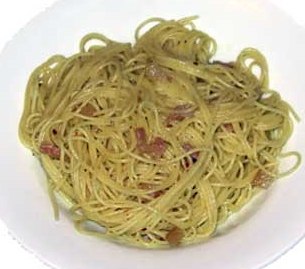| CLASSIC pasta | spaghetti alla gricia | |||
|
|
 This is the second of the properly famed simple Roman pasta dishes. The first is cacio e pepe (pepper and pecorino). This is the next in complexity (although not complex at all) and the other two are Amatriciana and Carbonara. The historic background to all of these superb pastas is explained by David Downie in his wonderful book "Cooking the Roman Way" (see library). Every kitchen should have the simple ingredients on hand to prepare these four classic pastas -- so for guests invited of the moment, a perfect presentation and taste treat is only moments away. The experts all agree that for a perfect alla grigia (just as for a perfect all'amatriciana or carbonara) one must use guanciale, an unsmoked Italian bacon from pig's cheeks, with its wonderful pork flavor and delicate composition. But let's face it, finding guanciale is not always possible. We re fortunate to have a new Italian salumeria in the Ferry Building in San Francisco, where we can find guanciale. Not all cities are so fortunate, but it is worth the effort to find it. So sometimes we use pancetta, and, frankly, some times we use very good bacon, with excellent results. The main thing is to keep it simple and enjoy! The other must is to use the classic Pecorino Romano -- the strong cheese needed here. Note that in this recipes -- according to all tradition -- there is no garlic and no onion. Mario Batali has a recipe that uses both of these. for the sauce:
for the pasta:
Bring 4-5 quarts of cold water to a heavy boil. Add a couple tablespoons of salt. In a saute pan, put in the olive oil over medium heat. Then add the guanciale and the red pepper flakes. We like to cut the guanciale (or the pancetta or bacon) into little squares. Others prefer strips. Cook, stirring, until it just starts to brown. It should not be crisp! Take it off the heat. If we are using bacon, we use only one tablespoon of olive oil at first, then cook the bacon until it is brown. Then remove it from the heat onto paper towels. Drain the fat from the pan. Add the remaining olive oil to the saute pan, and the red pepper flakes, and heat through. Return the bacon to the pan, stir, and set aside. Add the pasta to the boiling water, stirring it well to get it separated and mixed. Cook to al dente. Reserve a cup of the cooking liquid. Then drain, but a little wetness is a plus here. Put the pasta in the heated sauce, add at least a half cup of the reserved liquid, stir. Add a teaspoon of salt and several strong twists of the pepper mill -- enough for at least a tablespoon. Stir. Add the pecorino and stir. Do not over cheese. Mix it well. >>note: the incredible testers of Cook's magazine claim that at times the pecorino in this dish goes "lumpy". If you have that problem, they suggest pre-mixing: use half the reserved pasta liquid, and two tablespoons of heavy cream. Mix together and then add the pecorino to this mixture, stir until dissolved and add it to the pasta. Then the pepper. Stir some more. Serve immediately in heated bowls, adding more pecorino to the serving as wanted. |
|||